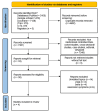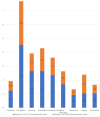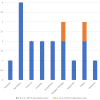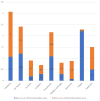Impact of Exercise on Perimenopausal Syndrome: A Systematic Review of Randomized Controlled Trials
- PMID: 40255746
- PMCID: PMC12008710
- DOI: 10.7759/cureus.80862
Impact of Exercise on Perimenopausal Syndrome: A Systematic Review of Randomized Controlled Trials
Abstract
Exercise has been contemplated as a natural means to alleviate the symptoms of perimenopause. The need for this study arises from the lack of data regarding the impact of exercise on the perimenopausal population. The primary objective of this systematic review of randomized controlled trials was to evaluate the impact of exercise in improving various symptoms of perimenopause, including hot flushes, insomnia, paresthesia, myalgia, arthralgia, palpitations, fatigue, headache, depression, vaginal dryness, and irritability in perimenopausal women. An extensive literature review was conducted according to Preferred Reporting Items for Systematic Reviews and Meta-Analyses (PRISMA) 2020 guidelines, examining the impact of exercise on relieving perimenopausal syndrome. The assessment was based on the readings of the Blatt-Kupperman Index (KI), a scale in which 11 symptoms of perimenopause are rated from 0 (absence of symptom) to 3 (severe). Based on the studies, there was a considerable reduction in the total KI score from baseline by 15.7%. Paresthesia and irritability reduced by 2 points on the scale and showed the greatest improvement. Headache, myalgia, fatigue, hot flushes, and insomnia decreased from an average score of 2 to 1. There was no significant improvement in psychiatric disorders such as depression. Furthermore, its efficacy in treating hot flushes is yet to be established, as discrepancies exist in the results. Exercise has been proven effective in treating mild to moderate perimenopausal symptoms. However, skepticism remains regarding its effectiveness in treating vasomotor symptoms, and further scrutiny is needed to establish it as a viable and effective therapy.
Keywords: climacteric symptoms; exercise; hot flashes; kupperman index; perimenopausal; perimenopause.
Copyright © 2025, Philip et al.
Conflict of interest statement
Conflicts of interest: In compliance with the ICMJE uniform disclosure form, all authors declare the following: Payment/services info: All authors have declared that no financial support was received from any organization for the submitted work. Financial relationships: All authors have declared that they have no financial relationships at present or within the previous three years with any organizations that might have an interest in the submitted work. Other relationships: All authors have declared that there are no other relationships or activities that could appear to have influenced the submitted work.
Figures







Similar articles
-
Effect of Gua sha therapy on perimenopausal syndrome: a randomized controlled trial.Menopause. 2017 Mar;24(3):299-307. doi: 10.1097/GME.0000000000000752. Menopause. 2017. PMID: 27760084 Clinical Trial.
-
Effect of health education combining diet and exercise supervision in Chinese women with perimenopausal symptoms: a randomized controlled trial.Climacteric. 2017 Apr;20(2):151-156. doi: 10.1080/13697137.2017.1281903. Epub 2017 Feb 1. Climacteric. 2017. PMID: 28145818 Clinical Trial.
-
Effects of stellate ganglion block on perimenopausal hot flashes: a randomized controlled trial.Front Endocrinol (Lausanne). 2023 Nov 28;14:1293358. doi: 10.3389/fendo.2023.1293358. eCollection 2023. Front Endocrinol (Lausanne). 2023. PMID: 38089617 Free PMC article. Clinical Trial.
-
Efficacy of mind-body therapies and exercise-based interventions on menopausal-related outcomes among Asian perimenopause women: A systematic review, meta-analysis, and synthesis without a meta-analysis.J Adv Nurs. 2020 May;76(5):1098-1110. doi: 10.1111/jan.14304. Epub 2020 Feb 17. J Adv Nurs. 2020. PMID: 31950541
-
Electroacupuncture for the treatment of perimenopausal syndrome: a systematic review and meta-analysis of randomized controlled trials.Acupunct Med. 2022 Apr;40(2):111-122. doi: 10.1177/09645284211055742. Epub 2021 Nov 9. Acupunct Med. 2022. PMID: 34753328
References
-
- Effect of health education combining diet and exercise supervision in Chinese women with perimenopausal symptoms: a randomized controlled trial. Xi S, Mao L, Chen X, Bai W. Climacteric. 2017;20:151–156. - PubMed
-
- Effects of physical exercise on health-related quality of life and blood lipids in perimenopausal women: a randomized placebo-controlled trial. Zhang J, Chen G, Lu W, et al. Menopause. 2014;21:1269–1276. - PubMed
-
- Postmenopausal hormone therapy: risks and benefits. Rozenberg S, Vandromme J, Antoine C. Nat Rev Endocrinol. 2013;9:216–227. - PubMed
-
- The effect of diet and exercise on climacteric symptomatology. Hao S, Tan S, Li J, Li W, Li J, Liu Y, Hong Z. Asia Pac J Clin Nutr. 2022;31:362–370. - PubMed
Publication types
LinkOut - more resources
Full Text Sources
